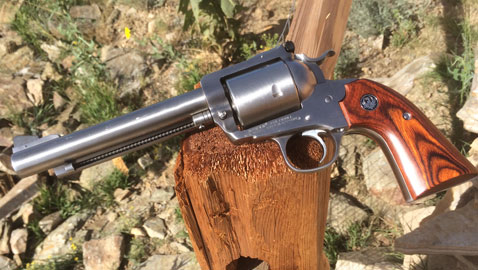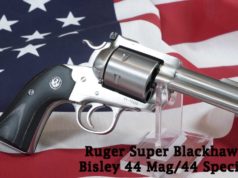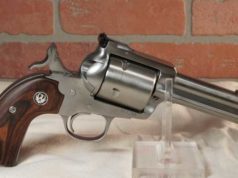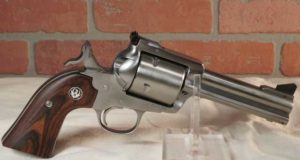I will be the first to tell you, big bore handguns are an acquired taste.
They do indeed buck and roar and do their best to put a hammer spur right between your eyes. Or, as Lee Martin, master gunsmith and the founder of the Single Action Forums where big bore aficionados hang out puts it: “Building carpal tunnel one round at a time.”
And yet there is something amazingly appealing about learning to shoot these brutes. That’s why I was so excited when my friends at Lipsey’s and Ruger teamed up to do what Ruger does best, shake up and reshape a market.
Meet the newest Ruger Super Blackhawk, 5-shot Bisley version available in both .454 Casull and .480 Ruger.
I can’t begin tell you just how cool the new Blackhawk boomers are. Up until this introduction, getting into big bores has been either a hard or expensive proposition, and in many cases both.
If you wanted a single action 5-shot Blackhawk in one of the heavy calibers, that meant a visit to one of the top revolver customizers in the world — John Linebaugh, Hamilton Bowen, Gary Reeder, Dave Clements, Alan Harton and the handful of other master gunsmiths who have the skills necessary to modify the big Ruger.
And make no mistake about it… it does takes a master to make those modifications. Big bore handgunning is an exercise in removing the margins, in the building and the shooting and the reloading. You can get away with a loose hold or a sloppy shooting position with, say, a .357 revolver. But if you try the same thing with a .500 Linebaugh or a .454 Casull, you quite literally run the risk of serious injury.
If you didn’t want to go the custom route, then you needed to beat a path to Freedom Arms or Magnum Research, and suffice to say neither are giving guns away (and in the case of Freedom Arms, there’s as of this time a 11-12 month waiting period as well).
Ruger and Lipsey’s literally changed the game with the intro of the new Super Blackhawks, putting big bore revolvers within reach of everyone. That classic market disruption seems to be a Ruger trademark — the new Ruger Precision Rifle has exactly the same effect, taking a high dollar pursuit by a niche market and opening it up to the larger shooting community. There is not yet an MSRP on the 5-shot Blackhawks, but Super Blackhawk Hunters clock in at $889, with standard Super Blackhawks at $769. I would expect the 5-shot guns slightly above that range.
Initial Impressions
In the video, you can see me shooting the .454 against my “control” .44 Magnum Hunter.
I like the 6.5 inch barrel a lot. I know a lot of guys swear by the 7.5 inch barrel — maybe some leftover homage to Sam Colt’s original Peacemakers — but I usually end up having 7.5 inch barrels cut down to something more convenient.
On a dedicated hunting gun like the Super Blackhawk .454, I’m good with 6.5 over my ideal 5.5 inch barrel. It does balance very well…I spent some time ringing steel with the various .454 loads, and it was no problemo. The 3.5 pound trigger is excellent… my custom Hamilton Bowen .44 Magnum Hunter has a 3.1 pound trigger pull, and that is as light as I would ever want on a field revolver. The 3.5 pound pull on the new Super Blackhawk is not just perfectly acceptable, but one that I’ll keep…and I am pissy about triggers…
The break is crisp with just a tiny bit of take-up and no over-travel to speak of. That little bit of take-up is slightly more than either my custom Hunter or my out-of-the-box 5.5-inch Super Blackhawk I bought years ago (the older SG runs a trigger pull of a bit over 5 pounds; I put a spring kit in “Thumper,” my oldest and most shot SB, when I replaced the steels grip frame with an aluminum one, and it breaks a 3.25 pounds).
As I mentioned, I have never been a fan of the Bisley grip frame…Colt introduced them on S.A.A. in 1894, intended as target revolvers (hence the name, “Bisley,” for the famous Brit target range). Ruger’s Bisley frames owe more to Elmer Keith and his experiments in big bore handgunning (culminating in the legendary No. 5, which recently went at auction for $70,000).
What has changed my mind is shooting powerful revolvers? I still like the classic “plow handle” design, but the Ruger Bisley does indeed handle heavy recoil better. John Taffin, who is as close to the modern Elmer Keith as any living human, wrote about the Ruger Bisley grip frame extensively in his classic BIG BORE HANDGUNS (which you must read…period) and various articles, such as this one on John Linebaugh’s boomers:
“When the Bisley was introduced, comments such as “If the grip was so good why did Colt drop it?” and “The Bisley grip is the answer to a problem that doesn’t exist!” were heard.
I disagree completely. First the Bisley grip as offered by Ruger is not the same as that found on the Colt Bisley. It is much closer to the old Number Five Single Action Grip that Elmer Keith promoted after it was designed by gunsmiths Harold Croft and J.D. O’Meara in the 1920’s. Secondly, for some of us there is a definite problem with heavy loads and standard single action grip frames. For me, the Super Blackhawk is especially punishing with heavy loads and catches my knuckle, and bangs my palm as well as the top of my trigger finger.
Detractors to the contrary, I will offer my personal opinion that the Ruger Bisley grip is the finest ever put on a factory single action. The grip is nearly perfect.”
By the way, for extra credit reading, you also need Max Prasac’s BIG BORE REVOLVERS. His encyclopedic discussion of big bore cartridges is superb. For other reference links, see below the article.
Barrels are 1:24 twist as opposed to the tradition 1:15 for .45 Colt.
The new 5-shot guns feature a screw-locking base pin, IMHO a necessity on heaving recoiling revolvers. Most of us routinely spend money on additional like Belt Mountain’s locking base pins. I can assure you that you will do exactly the same thing the first time your launch a Ruger basin across the range. Good that Ruger recognized this up front.
The gun is heavy (50.2 ounces), but hey, Super Blackhawks are all heavy…why I stuck an aluminum frame on “Thumper” in the first place. And trust me, somewhere around the third Hornady 300-gr XTP you’ll appreciate all 50.2 of those ounces!
The .454 Casull grew out of the on-going experimentation with heavy .45 Colt loads. One of the problems with heavy .45 Colt loads is that .45 Colt revolver have been around for a long time, like since 1873, and sooner or later a heavy load will wreak havoc on a classic S.A.A…. or even a Ruger Blackhawk if you’re stupid enough. John Linebaugh has written the standard article on .45 Colt handgun strength, in which he says:
“Now that we know just how strong the guns are we are working with perhaps you figure you can heat up the a loads a bit. Such “logical thinking” jaspers will get a REAL LOAD.
Overloading often times does no visible harm, but stress and fatigue go unnoticed till something lets go. In this era when shooters and hunters are looked over very critically we need safe responsible hunters, shooters and HANDLOADERS. THIS MEANS YOU!”
Read the whole thing…there will be a test!
In the late 1950s Dick Casull, who had been corresponding with Elmer Keith, decided to “magnumize” the .45 Colt. The result was the .454 Casull…since it has a slightly longer case, similar to the relationship between .38 Special and .357 Magnum and .44 Special and .44 Magnum, it was unlikely that shooters with a death wish could stuff the new rounds into old Colts.
The first cataloged production .454s were built by Freedom Arms in the early 1980s, whose founder, Wayne Baker, worked with Dick Casull on the guns. The first .454 I shot was earlier than that, in the late 1970s, a United Sports Arms/Seville in “.454 Magnum,” one of 30 made. I have that gun now… you can read about it on my blog here:
http://michaelbane.blogspot.com/2006/07/fresh-stainless-steel-meat.html
I think the .454 Super Blackhawk shoots great. If you’re one of those guys who love the idea of hotting up .45 Colts, I would strongly suggest you go to the .454 Blackhawk. There’s a lot to be said for hot .45 Colt set-ups…the brass is readily available and inexpensive compared to the Casull brass (from Starline Brass — .45 Colt, $106 for 500 pieces; .454 Casull, $168 for 500 pieces).
And one of the huge advantages of the .454 over the .480 Ruger — a fine cartridge in its own right — is the ability to shoot .45 Colt ammo. I like to practice, but I’ve grown to love my wrists, too. One of the most painful experiences I’ve ever had shooting was a competition between me and a legendary Harley engine builder with both of us shooting custom 5-shot Ruger round-butt Vaqueros with heavy .45 Colt 300-grainers. After an afternoon on the dueling tree, I went back to the hotel, soaked my right hand in ice and finally wrapped my both my wrists with Ben-Gay patches.
I plan to do the accuracy testing on the new Ruger with Garrett Cartridge’s new .454 Hammerheads. Max Prasac tells me he’s gotten excellent accuracy from these loads. BTW, notice that similar loading is available for the .45 Colt in certain platforms!
We’ll file the second part of this report after the testing… somewhere, there’s a hog with this revolver’s name on it!
Lee Martin Single Action Forums
Lipsey’s Wholesale Firearms Distributors
Lyman Digital Trigger Pull Gauge
BIG BORE HANDGUNS, by John Taffin
“The Big Bore Handguns of John Linebaugh,” by John Taffin
BIG BORE REVOLVERS, by Max Prasac
“The .45 Colt — Dissolving the Myth; Discovering the Legend,” by John Linebaugh





Love these guns bought both a 454 & a 480 after seeing Michael’s blog. Had to hound a gun store till they turned the lights off & closed the blinds when they saw me coming to get them though. You are not going to just stumble across one of these guns. If you want one get in line. Great video. I’ll hunt with my 454 but I love shooting the 480 it’s a sweetheart to shoot compared to the 454. Someday it will grow up & become a 475. But for now I’ll just continue to train/practice Michael’s tips for proper big bore shooting.